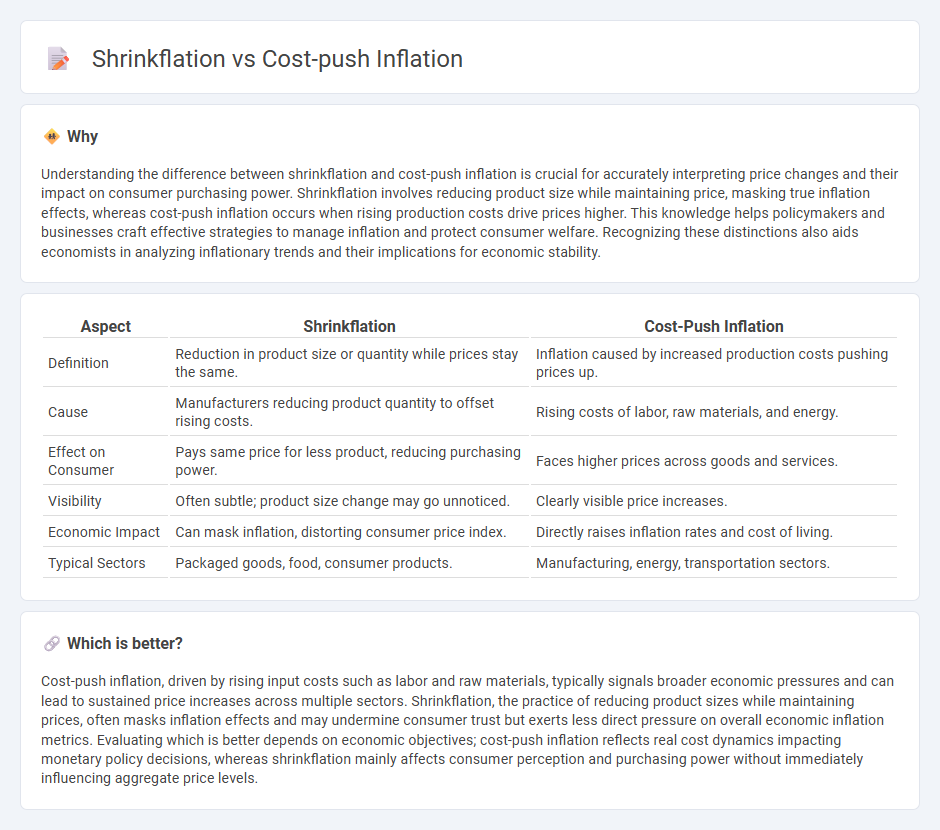
Shrinkflation occurs when companies reduce product size or quantity while maintaining the same price, subtly increasing costs for consumers without overt price hikes. Cost-push inflation arises from rising production costs, such as higher wages or raw material prices, which push overall prices upward across the economy. Discover how these economic phenomena impact your purchasing power and market stability.
Why it is important
Understanding the difference between shrinkflation and cost-push inflation is crucial for accurately interpreting price changes and their impact on consumer purchasing power. Shrinkflation involves reducing product size while maintaining price, masking true inflation effects, whereas cost-push inflation occurs when rising production costs drive prices higher. This knowledge helps policymakers and businesses craft effective strategies to manage inflation and protect consumer welfare. Recognizing these distinctions also aids economists in analyzing inflationary trends and their implications for economic stability.
Comparison Table
| Aspect | Shrinkflation | Cost-Push Inflation |
|---|---|---|
| Definition | Reduction in product size or quantity while prices stay the same. | Inflation caused by increased production costs pushing prices up. |
| Cause | Manufacturers reducing product quantity to offset rising costs. | Rising costs of labor, raw materials, and energy. |
| Effect on Consumer | Pays same price for less product, reducing purchasing power. | Faces higher prices across goods and services. |
| Visibility | Often subtle; product size change may go unnoticed. | Clearly visible price increases. |
| Economic Impact | Can mask inflation, distorting consumer price index. | Directly raises inflation rates and cost of living. |
| Typical Sectors | Packaged goods, food, consumer products. | Manufacturing, energy, transportation sectors. |
Which is better?
Cost-push inflation, driven by rising input costs such as labor and raw materials, typically signals broader economic pressures and can lead to sustained price increases across multiple sectors. Shrinkflation, the practice of reducing product sizes while maintaining prices, often masks inflation effects and may undermine consumer trust but exerts less direct pressure on overall economic inflation metrics. Evaluating which is better depends on economic objectives; cost-push inflation reflects real cost dynamics impacting monetary policy decisions, whereas shrinkflation mainly affects consumer perception and purchasing power without immediately influencing aggregate price levels.
Connection
Shrinkflation and cost-push inflation are interconnected phenomena where businesses respond to rising production costs, driven by factors like increased raw material prices and supply chain disruptions, by reducing product sizes instead of raising prices outright. This strategy allows companies to maintain profit margins while mitigating consumer price sensitivity in an inflationary environment characterized by supply-side cost pressures. Both contribute to the subtle erosion of consumer purchasing power, complicating inflation measurement and economic policy responses.
Key Terms
Production Costs
Cost-push inflation arises when increased production costs, such as rising raw material prices or higher wages, force producers to raise product prices to maintain profit margins. Shrinkflation occurs when companies reduce the size or quantity of a product while keeping the price constant to offset these higher costs without directly increasing prices. Explore deeper insights into how production costs influence these economic phenomena and their impact on consumer behavior.
Price Levels
Cost-push inflation occurs when rising production costs, such as wages and raw materials, drive up overall price levels in the economy. Shrinkflation involves reducing product size or quantity while maintaining the same price, effectively increasing the per-unit cost to consumers without a visible price increase. Explore the detailed impacts of both phenomena on consumer behavior and economic stability.
Product Size/Quality
Cost-push inflation occurs when rising production costs, such as higher wages or raw material prices, force manufacturers to increase product prices to maintain profit margins. Shrinkflation, on the other hand, involves reducing the product size or quality while keeping prices steady to mask inflationary pressures and preserve sales volume. Discover more about how these economic phenomena impact consumer purchasing decisions and brand strategies.
Source and External Links
Cost-Push Inflation - Economics Help - Cost-push inflation occurs when rising prices are due to higher production costs and raw material costs, driven by supply-side factors.
Cost-Push Inflation: Definition & Examples - SmartAsset - Cost-push inflation happens when increased production costs are passed on to consumers, often due to higher labor or material costs.
Cost-push inflation - Wikipedia - Cost-push inflation is caused by increases in the cost of essential goods or services where no suitable alternatives exist, forcing businesses to raise prices.
 dowidth.com
dowidth.com